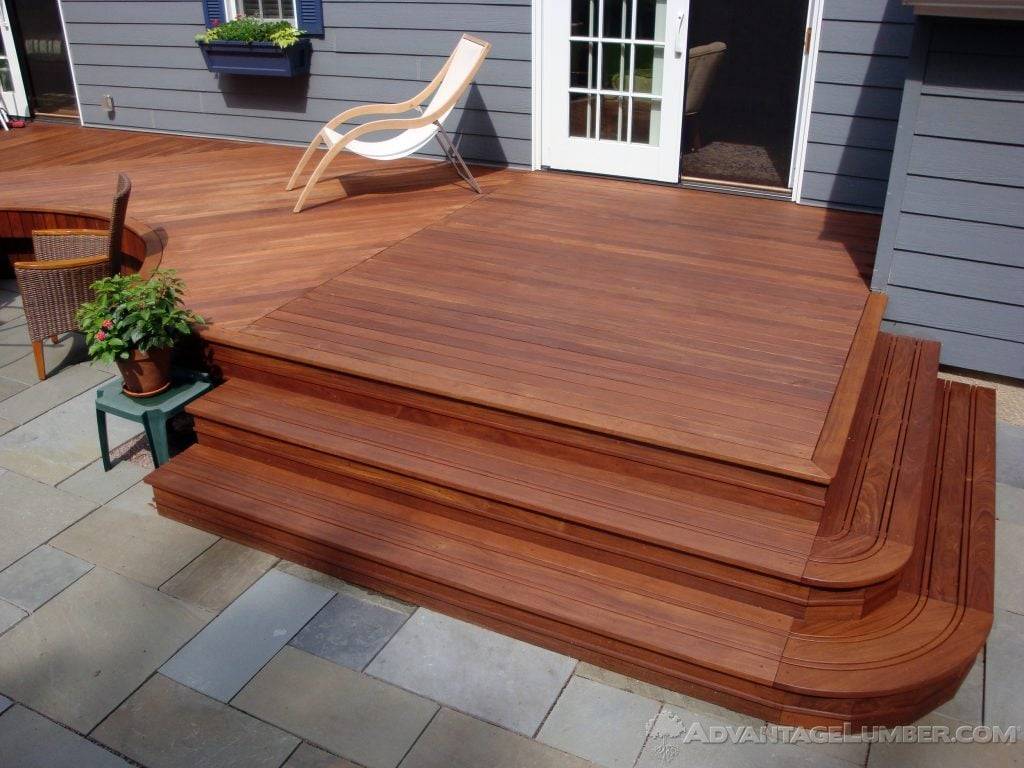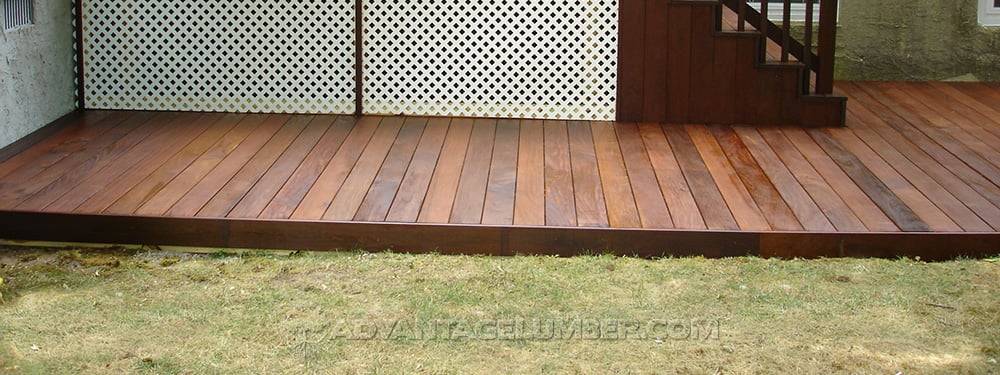Ground-level decks are a popular option when designing backyard landscapes. But if you don’t take certain precautions, your dream outdoor living space can quickly become a maintenance nightmare. To ensure you get the most out of your ground-level deck, here are several things to keep in mind during the planning stage.
1. Ground-Level Decks Lack Ventilation
The number-one reason ground-level decking projects fail is a lack of ventilation. We always recommend at least 18 inches of ground clearance to allow for good air flow, but ground-level decks, by definition, flout this rule. Therefore, we don’t usually recommend building a deck at ground level.
So what happens? The deck boards cup. Moisture on top of the boards can evaporate thanks to its exposure to open air, but moisture under the boards is trapped. Since wood shrinks as it dries out, the tops of the boards contract. At the same time, wet wood expands, so the bottoms swell out. These two opposed motions cause the boards to curl upward—better known in the decking world as cupping.
There’s very little you can do to improve air flow in a ground-level deck, but there are some steps you can take to minimize the negative effects of poor ventilation.
2. Use Strong Hardwoods
South American hardwoods, which include species like ipe and cumaru, are some of the strongest decking materials in the world. Their dense grain structures resist cupping better than softer woods like cedar or pine. They also contain natural oils that help them to resist moisture and the problems associated with it.
3. Use Thicker Boards
It’s easy to roll up a single sheet of paper, but try doing it with an entire ream! The thicker your material, the harder it is to bend—or in our case, the less likely it is to cup. So when choosing your decking material, thicker boards are better. 5/4x or even 2x boards may be more expensive, but the hassle they’ll save will be well worth the extra cost.
4. Use Narrower Boards

Similar to the above point, a narrow board is less likely to cup than a wide board. Going back to the paper analogy, it’s generally easier to fold a piece of paper perpendicular to its long axis than its short axis, and the same principle holds with wood. Also, because the board is narrower, any cupping that does occur will be less extreme, simply because there’s less material to expand and contract. So when planning your deck, choose 4-inch boards instead of the typical 6-inch boards.
5. Oil the Boards Before Installing
As stated earlier, all of our hardwood decking species contain natural oils that help them resist moisture-related problems. But you can further protect the wood by coating each board with a special oil-based finish prior to installation. We recommend Ipe Oil, since it was specially formulated to work with Brazilian hardwoods. Be sure to coat all four sides!
6. Use Wider Gap Spacing
For ipe decking, we typically recommend 3/32-inch gaps between boards, and a 1/4-inch gap for our other decking species. Slightly increasing this gap can improve the air flow, even if only by a little. It won’t have a huge impact, but every bit counts!
7. Oil Regularly After Installation
South American hardwoods are known for being low-maintenance, but with a ground-level deck, you’re going to have to do some work. Annual oil coatings, using the same stuff you used prior to installation, will maximize the stability of your deck boards.
8. Build a Ground-Level Deck with Deck Tiles
While the above tips will help, traditional ground-level decks never come with a guarantee. At the end of the day, you’re still fighting against wood’s natural tendencies when installing so close to the ground.

But there is one other option. Hardwood deck tiles are made from narrow slats of wood and pre-assembled to resist cupping. They are designed specifically for ground-level use! As a bonus, deck tiles are also a lot easier to install than traditional deck boards.
Conclusion
It should be repeated that we usually try to steer customers away from ground-level deck projects because the risks of moisture-related problems are too great. But if your heart is set on a deck at or near ground level, then these tips will give you the best chances at success.

I have a deck that needs totally redone. This was so informative Zaza with which kinds of woods to use, the strength, ect. Ipe Decking was something new I learned about. Thank you!
Great info that a lot of people don’t consider when building a ground level deck.
We have a complete wrap around covered porch. Right now we have white lime stone. I would like to do some kind of decking. What do you suggest.
Ipe, Teak or Cumaru should like nice with the stone!
– Make sure there is proper drainage under the deck. Use a woven fabric under gravel. Woven keeps more moisture in the soil than non-woven while still allowing drainage and run-off.
– Cut relief kerfs on the underside of the boards. With a 3 1/2″ board run two slots the length of the boards dividing the board into equal thirds. The kerfs should be 3/8 deep on a 5/4 board. The kerfs allow space for the board to expand avoiding cupping.
– Use wider joists so you can double up hidden fasteners. Much stronger to hold down the board and more secure should one fail. 4×4’s or a 2x joist with a sister’d 2×4 or even 2×2 are ways to go wider at the surface.